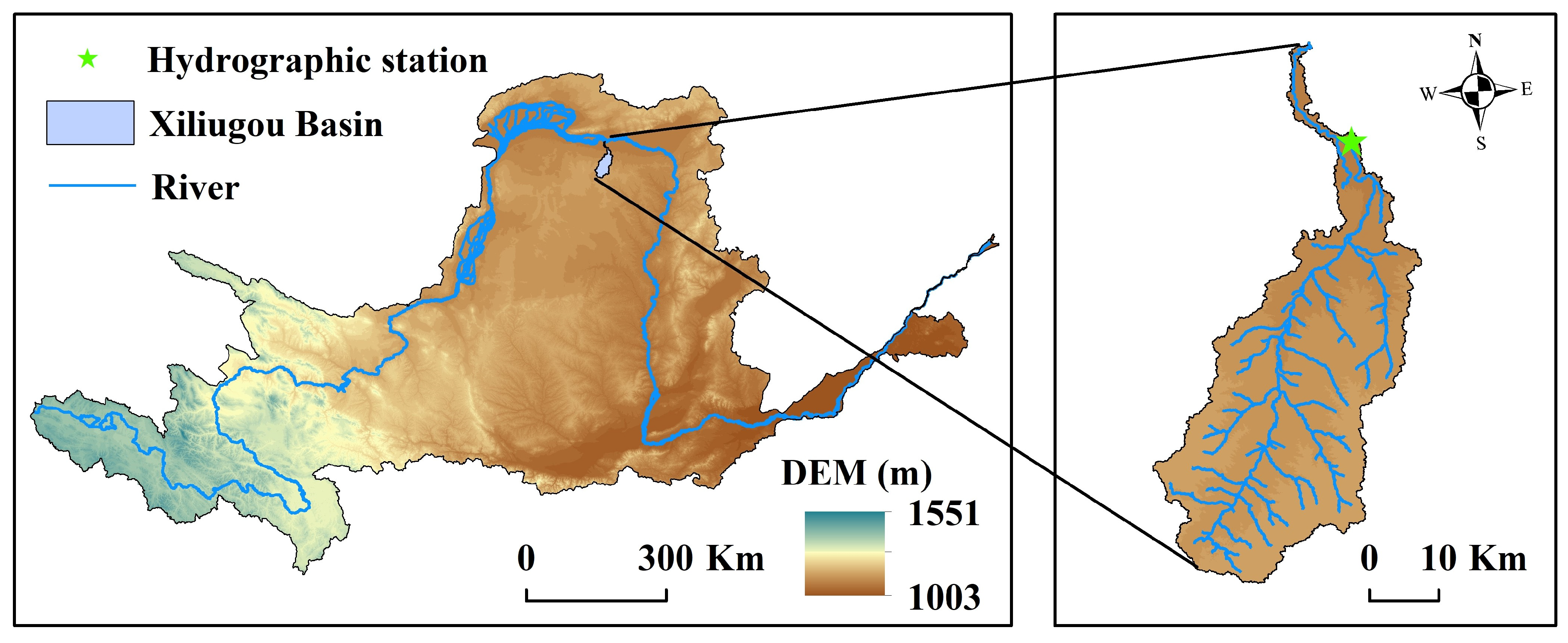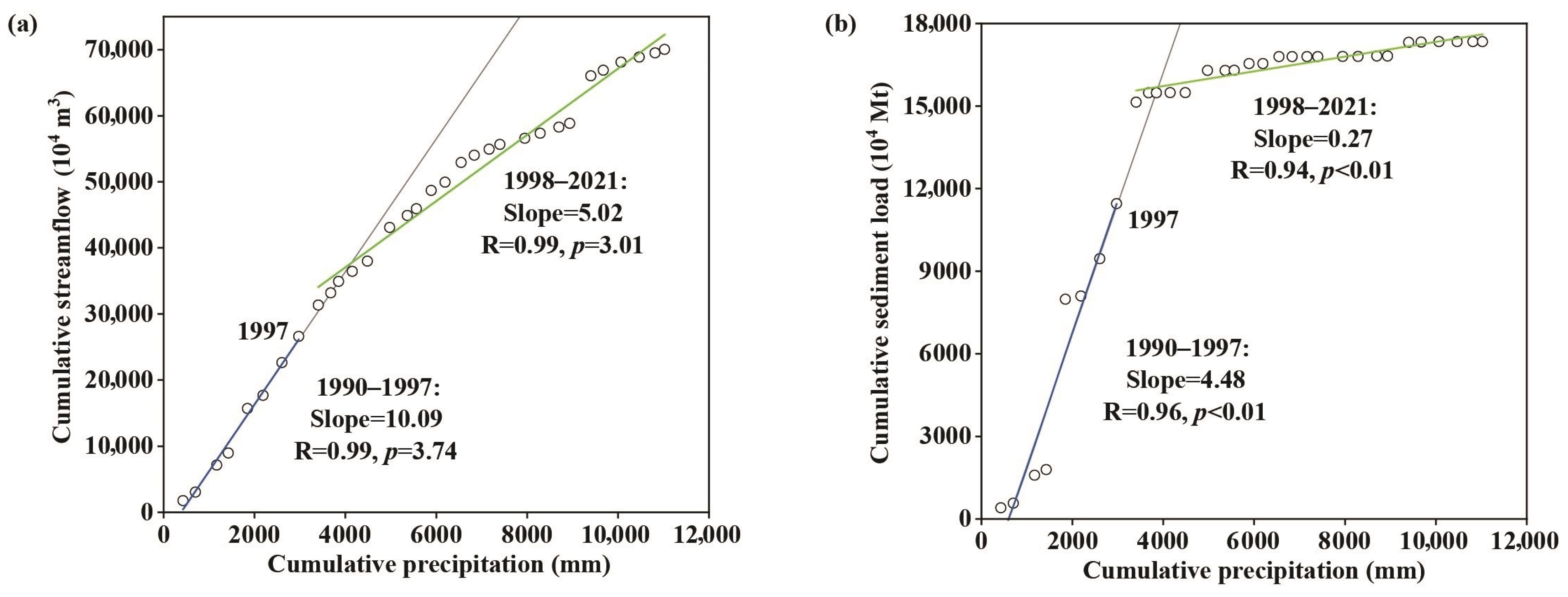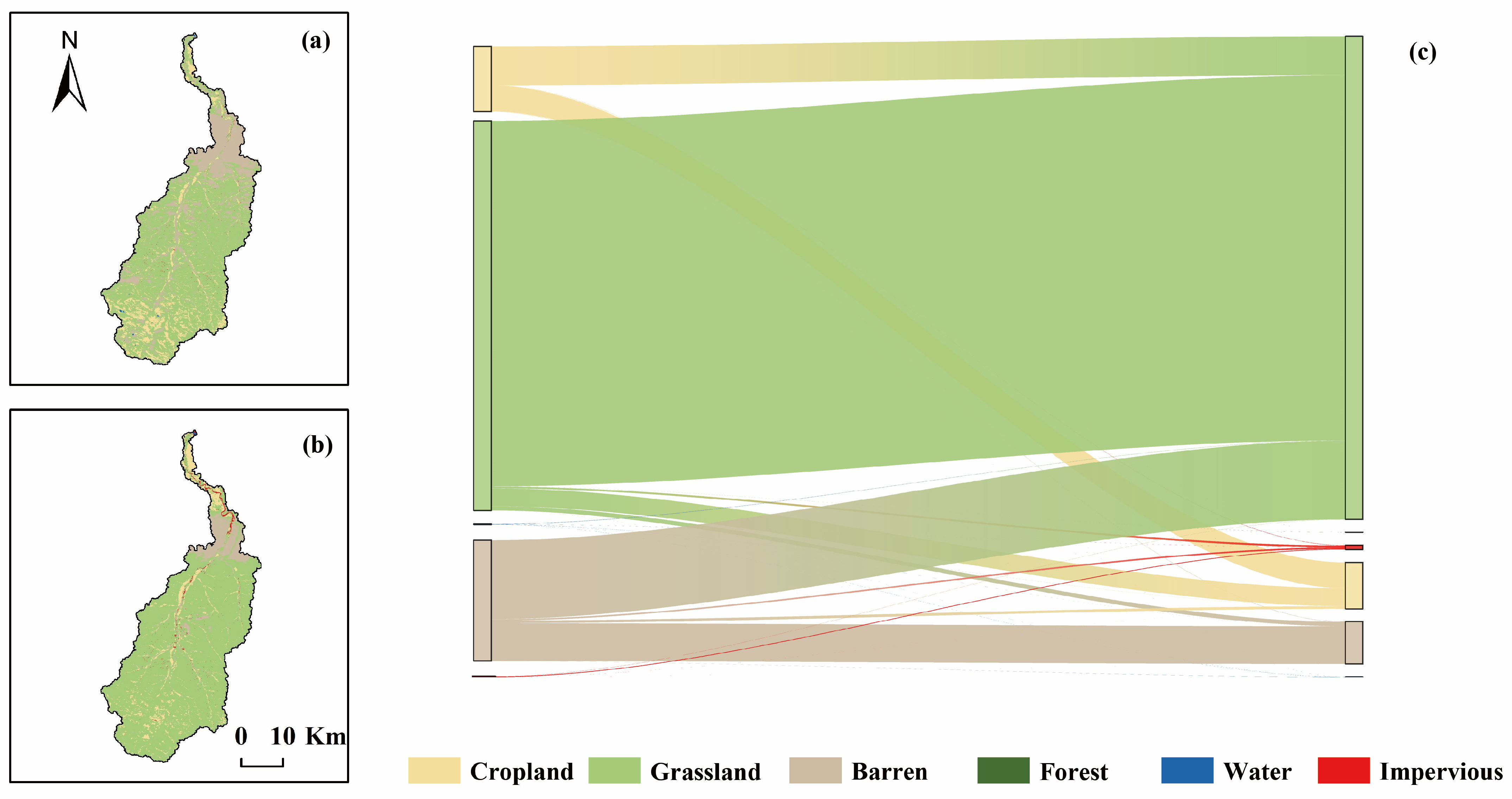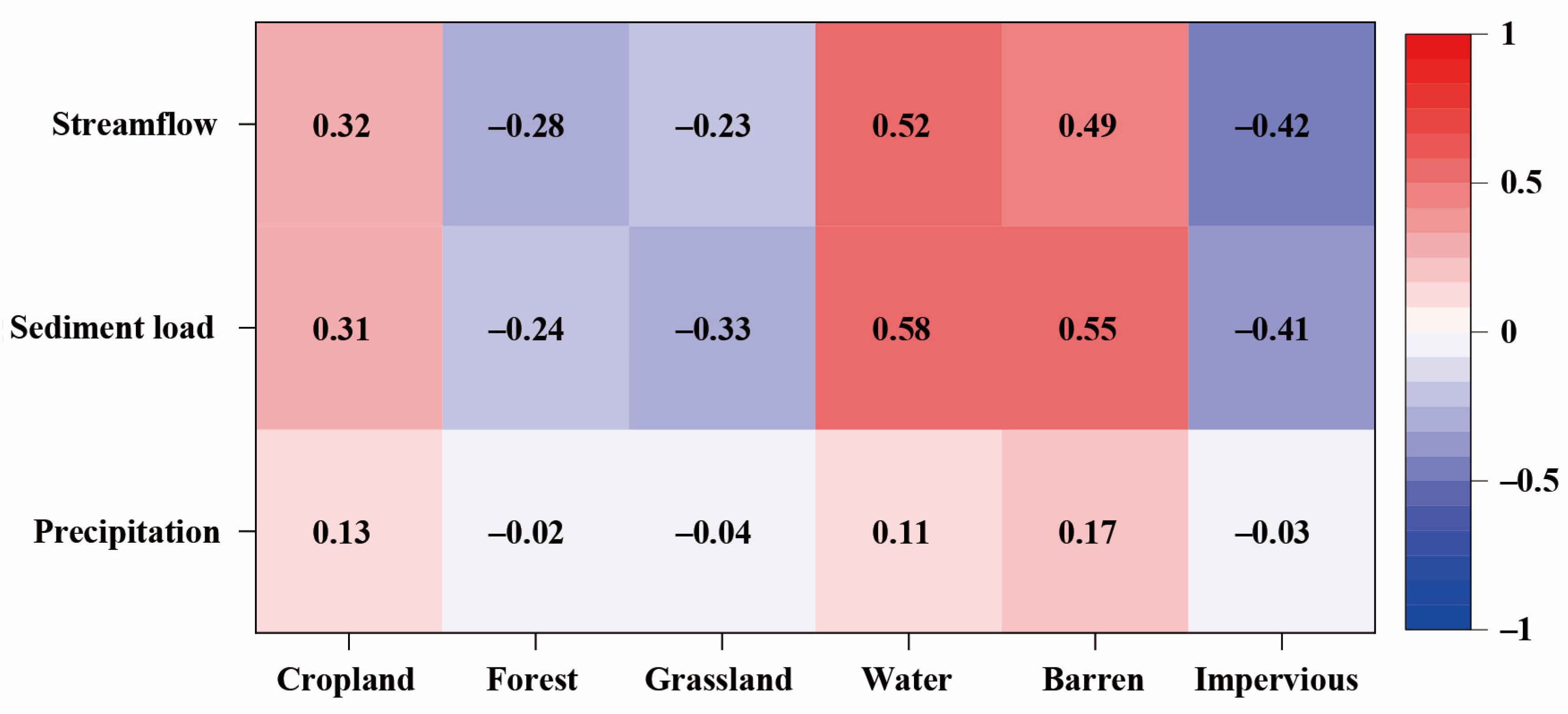Quantitative Contributions of Climate and Human Activities to Streamflow and Sediment Load in the Xiliugou Basin of China
Abstract
:1. Introduction
2. Methodology
2.1. Study Region
2.2. Dataset
2.3. Methods
2.3.1. Coefficient of Variation (CV)
2.3.2. Bayesian Change Point Detection
2.3.3. Correlation Analysis
2.3.4. Double Mass Curve (DMC)
3. Results
3.1. Dynamic Variation Characteristics of Hydrological and Meteorological Variables
3.1.1. Variation Trends of Streamflow and Sediment Load
3.1.2. Mutation Characteristics of Streamflow and Sediment Load
3.2. Contribution of Factors to Streamflow and Sediment Load
3.3. Influence of Land Use on Streamflow and Sediment Load
3.3.1. Land Use Changes
3.3.2. Correlation Analysis
4. Discussion
5. Conclusions
- (1)
- From 1990 to 2021, streamflow, sediment load, and precipitation in the Xiliugou Basin exhibited decreasing trends (with change rates of −77.76 × 104 m3/year, −55.97 × 104 Mt/year, and −0.84 mm/year, respectively), showing a generally consistent overall trend. Intra-annual distribution of streamflow and sediment load in the basin was uneven, with 61.05% of precipitation occurring during the wet season.
- (2)
- The years of significant change points in annual streamflow and sediment load were consistent, occurring around 1997. Fluctuations were evident in both streamflow and sediment load from the reference period to the change period, with reductions of 45.54% and 82.85%, respectively.
- (3)
- The double cumulative curves revealed that human activities significantly reduced sediment load in the Xiliugou Basin from 1998 to 2021, with human activities contributing 115.08% to this reduction.
- (4)
- The correlation between land use types and streamflow/sediment load was stronger than that with precipitation. Increases in cropland, water area, and barren land led to higher streamflow and sediment load, while expansions in forest, grassland, and impervious areas resulted in decreased streamflow and sediment load.
Author Contributions
Funding
Institutional Review Board Statement
Informed Consent Statement
Data Availability Statement
Acknowledgments
Conflicts of Interest
References
- O’Donoghue, C.; Meng, Y.; Ryan, M.; Kilgarriff, P.; Zhang, C.; Bragina, L.; Daly, K. Trends and Influential Factors of High Ecological Status Mobility in Irish Rivers. Sci. Total Environ. 2022, 816, 151570. [Google Scholar] [CrossRef] [PubMed]
- Yin, S.; Gao, G.; Li, Y.; Xu, Y.J.; Turner, R.E.; Ran, L.; Wang, X.; Fu, B. Long-Term Trends of Streamflow, Sediment Load and Nutrient Fluxes from the Mississippi River Basin: Impacts of Climate Change and Human Activities. J. Hydrol. 2023, 616, 128822. [Google Scholar] [CrossRef]
- Milly, P.C.D.; Dunne, K.A.; Vecchia, A.V. Global Pattern of Trends in Streamflow and Water Availability in a Changing Climate. Nature 2005, 438, 347–350. [Google Scholar] [CrossRef] [PubMed]
- Cohen, S.; Kettner, A.J.; Syvitski, J.P.M. Global Suspended Sediment and Water Discharge Dynamics between 1960 and 2010: Continental Trends and Intra-Basin Sensitivity. Global Planet. Chang. 2014, 115, 44–58. [Google Scholar] [CrossRef]
- Yin, S.; Gao, G.; Ran, L.; Li, D.; Lu, X.; Fu, B. Extreme Streamflow and Sediment Load Changes in the Yellow River Basin: Impacts of Climate Change and Human Activities. J. Hydrol. 2023, 619, 129372. [Google Scholar] [CrossRef]
- IPCC. Summary for Policymakers. In Climate Change 2022: Impacts, Adaptation and Vulnerability. Contribution of Working Groups II to the Six Assessment Report of the Intergovernmental Panel on Climate Change; IPCC: Geneva, Switzerland, 2022. [Google Scholar]
- Syvitski, J.P.M.; Vörösmarty, C.J.; Kettner, A.J.; Green, P. Impact of Humans on the Flux of Terrestrial Sediment to the Global Coastal Ocean. Science 2005, 308, 376–380. [Google Scholar] [CrossRef] [PubMed]
- Gudmundsson, L.; Boulange, J.; Do, H.X.; Gosling, S.N.; Grillakis, M.G.; Koutroulis, A.G.; Leonard, M.; Liu, J.; Schmid, M.H.; Papadimitriou, L.; et al. Globally Observed Trends in Mean and Extreme River Flow Attributed to Climate Change. Science 2021, 371, 1159–1162. [Google Scholar] [CrossRef] [PubMed]
- Walling, D.E.; Fang, D. Recent Trends in the Suspended Sediment Loads of the World’s Rivers. Global Planet. Chang. 2003, 39, 111–126. [Google Scholar] [CrossRef]
- Gao, P.; Zhang, X.; Mu, X.; Wang, F.; Li, R.; Zhang, X. Trend and Change-Point Analyses of Streamflow and Sediment Discharge in the Yellow River during 1950–2005. Hydrolog. Sci. J. 2010, 55, 275–285. [Google Scholar] [CrossRef]
- Xin, Z.B.; Yu, B.F.; Han, Y.G. Spatiotemporal Variations in Annual Sediment Yield from the Middle Yellow River, China, 1950–2010. J. Hydrol. Eng. 2024, 20, 04014090. [Google Scholar]
- Chalov, S.; Prokopeva, K.; Magritsky, D.; Grigoriev, V.; Fingert, E.; Habel, M.; Juhls, B.; Morgenstern, A.; Overduin, P.P.; Kasimov, N. Climate Change Impacts on Streamflow, Sediment Load and Carbon Fluxes in the Lena River Delta. Ecol. Indic. 2023, 157, 111252. [Google Scholar] [CrossRef]
- Feng, Z.; Liu, S.; Guo, Y.; Liu, X. Runoff Responses of Various Driving Factors in a Typical Basin in Beijing-Tianjin-Hebei Area. Remote Sens. 2023, 15, 1027. [Google Scholar] [CrossRef]
- Luan, J.; Zhang, Y.; Ma, N.; Tian, J.; Li, X.; Liu, D. Evaluating the Uncertainty of Eight Approaches for Separating the Impacts of Climate Change and Human Activities on Streamflow. J. Hydrol. 2021, 601, 126605. [Google Scholar] [CrossRef]
- Zhang, Q.; Xu, C.Y.; Singh, V.P.; Yang, T. Multiscale Variability of Sediment Load and Streamflow of the Lower Yangtze River Basin: Possible Causes and Implications. J. Hydrol. 2009, 368, 96–104. [Google Scholar] [CrossRef]
- Eccles, R.; Zhang, H.; Hamilton, D.; Trancoso, R.; Syktus, J. Impacts of Climate Change on Nutrient and Sediment Loads from a Subtropical Catchment. J. Environ. Manag. 2023, 345, 118738. [Google Scholar] [CrossRef] [PubMed]
- Du, J.; Shi, C. Effects of Climatic Factors and Human Activities on Runoff of the Weihe River in Recent Decades. Quat. Int. 2012, 282, 58–65. [Google Scholar] [CrossRef]
- Wei, D.; Liu, S.; Wu, Y.; Feng, S.; Gao, H.; Qin, C.; Ren, D.; Tang, W.; Zhang, Y. Impacts of Human Activities and Climate Change on Water and Sediment Evolution in Four Large Subtropical River Basins in China. Ecol. Indic. 2023, 155, 110958. [Google Scholar] [CrossRef]
- Gao, P.; Li, P.; Zhao, B.; Xu, R.; Zhao, G.; Sun, W.; Mu, X. Use of Double Mass Curves in Hydrologic Benefit Evaluations. Hydrol. Process. 2017, 31, 4639–4646. [Google Scholar] [CrossRef]
- Yin, S.; Gao, G.; Huang, A.; Li, D.; Ran, L.; Nawaz, M.; Xu, Y.J.; Fu, B. Streamflow and Sediment Load Changes from China’s Large Rivers: Quantitative Contributions of Climate and Human Activity Factors. Sci. Total Environ. 2023, 876, 162758. [Google Scholar] [CrossRef]
- Xu, X.; Yang, D.; Yang, H.; Lei, H. Attribution Analysis Based on the Budyko Hypothesis for Detecting the Dominant Cause of Runoff Decline in Haihe Basin. J. Hydrol. 2014, 510, 530–540. [Google Scholar] [CrossRef]
- Feng, D.; Zheng, Y.; Mao, Y.; Zhang, A.; Wu, B.; Li, J.; Tian, Y.; Wu, X. An Integrated Hydrological Modeling Approach for Detection and Attribution of Climatic and Human Impacts on Coastal Water Resources. J. Hydrol. 2018, 557, 305–320. [Google Scholar] [CrossRef]
- Jehanzaib, M.; Shah, S.A.; Kwon, H.H.; Kim, T.W. Investigating the Influence of Natural Events and Anthropogenic Activities on Hydrological Drought in South Korea Terrestrial Atmospheric and Oceanic. Sciences 2020, 31, 85–96. [Google Scholar]
- Xue, L.; Yang, F.; Yang, C.; Chen, X.; Zhang, L.; Chi, Y.; Yang, G. Identification of potential impacts of climate change and anthropogenic activities on streamflow alterations in the Tarim River Basin, China. Science 2017, 7, 8254. [Google Scholar] [CrossRef]
- Hu, T.; Toman, E.; Chen, G.; Shao, G.; Zhou, Y.; Li, Y.; Zhao, K.; Feng, Y. Mapping fine-scale human disturbances in a working landscape with Landsat time series on Google Earth Engine. ISPRS J. Photogramm. 2021, 176, 250–261. [Google Scholar] [CrossRef]
- Santikari, V.P.; Murdoch, L.C. Effects of Construction-Related Land Use Change on Streamflow and Sediment Yield. J. Environ. Manag. 2019, 252, 109605. [Google Scholar] [CrossRef] [PubMed]
- Chiang, L.C.; Shih, P.C.; Lu, C.M.; Jhong, B.C. Strategies Analysis for Improving SWAT Model Accuracy and Representativeness of Calibrated Parameters in Sediment Simulation for Various Land Use and Climate Conditions. J. Hydrol. 2023, 626, 130124. [Google Scholar] [CrossRef]
- Briak, H.; Mrabet, R.; Moussadek, R.; Aboumaria, K. Use of a Calibrated SWAT Model to Evaluate the Effects of Agricultural BMPs on Sediments of the Kalaya River Basin (North of Morocco). Int. Soil Water Conserv. 2019, 7, 176–183. [Google Scholar] [CrossRef]
- Fitri, A.; Maulud, K.N.A.; Rossi, F.; Dewantoro, F.; Harsanto, P.; Zuhairi, N.Z. Spatial and Temporal Distribution of Dissolved Oxygen and Suspended Sediment in Kelantan River Basin. In Proceedings of the 4th International Conference on Sustainable Innovation 2020–Technology, Engineering and Agriculture (ICoSITEA 2020), Yogyakarta, Indonesia, 13–14 October 2021; Volume 199, pp. 51–54. [Google Scholar]
- Yang, H.; Shi, C. Spatial and Temporal Variations of Aeolian Sediment Input to the Tributaries (the Ten Kongduis) of the Upper Yellow River. Aeolian Res. 2018, 30, 1–10. [Google Scholar] [CrossRef]
- Yao, H.; Shi, C.; Shao, W.; Bai, J.; Yang, H. Changes and Influencing Factors of the Sediment Load in the Xiliugou Basin of the Upper Yellow River, China. Catena 2016, 142, 1–10. [Google Scholar] [CrossRef]
- Yu, X.; Liu, H.; Wang, Q.; Kou, X.; Cao, X.; Xu, Z.; Wen, L.; Zhuo, Y.; Wang, L. Hydrochemical and Stable Isotope Characteristics of Surface Water and Groundwater in Xiliugou and Wulagai River Basin, North China. Ecohydrol. Hydrobiol. 2024, 24, 62–72. [Google Scholar] [CrossRef]
- Wu, X.; Liu, H.; Guo, X.; Zhang, Z.; Zhang, J.; Huang, X. Microplastic distribution and migration in soil, water and sediments in Caohai Lake under the different hydrological periods, Southwest China. Sci. Total Environ. 2023, 865, 161292. [Google Scholar] [CrossRef] [PubMed]
- CGIAR-CSI. SRTM DEM Dataset in China (2000); A Big Earth Data Platform for Three Poles. 2013. Available online: http://60.245.210.47/en/data/acb49ce8-2bfe-4ab4-97ff-e6e727110703/?q= (accessed on 5 April 2024).
- Yang, J.; Huang, X. The 30 m annual land cover dataset and its dynamics in China from 1990 to 2019. Earth Syst. Sci. Data 2021, 13, 3907–3925. [Google Scholar] [CrossRef]
- Teutschbein, C.; Grabs, T.; Laudon, H.; Karlsen, R.H.; Bishop, K. Simulating Streamflow in Ungauged Basins under a Changing Climate: The Importance of Landscape Characteristics. J. Hydrol. 2018, 561, 160–178. [Google Scholar] [CrossRef]
- White, J.; Walsh, J.; Thoman, R. Using Bayesian Statistics to Detect Trends in Alaskan Precipitation. Int. J. Climatol. 2020, 41, 2045–2059. [Google Scholar] [CrossRef]
- Cai, Y.; Liu, S.; Lin, H. Monitoring the Vegetation Dynamics in the Dongting Lake Wetland from 2000 to 2019 Using the BEAST Algorithm Based on Dense Landsat Time Series. Appl. Sci. 2020, 10, 4209. [Google Scholar] [CrossRef]
- Zhao, K.; Wulder, M.A.; Hu, T.; Bright, R.; Wu, Q.; Qin, H.; Li, Y.; Toman, E.; Mallick, B.; Zhang, X.; et al. Detecting Change-Point, Trend, and Seasonality in Satellite Time Series Data to Tack Abrupt Changes and Nonlinear Dynamics: A Bayesian Ensemble Algorithm. Remote Sens. Environ. 2019, 232, 111181. [Google Scholar] [CrossRef]
- Zhang, Z.; Wang, Z.; Lai, H.; Wang, F.; Li, Y.; Feng, K.; Qi, Q.; Di, D. Lag Time and Cumulative Effects of Climate Factors on Drought in North China Plain. Water 2023, 15, 3428. [Google Scholar] [CrossRef]
- Comiti, F.; Mao, L.; Penna, D.; Dell’Agnese, A.; Engel, M.; Rathburn, S.; Cavalli, M. Glacier melt runoff controls bedload transport in Alpine catchments. Earth Planet. Sci. Lett. 2019, 520, 77–86. [Google Scholar] [CrossRef]
- Van Pelt, W.; Pohjola, V.; Pettersson, R.; Ehwald, L.; Reijmer, C.; Boot, W.; Jakobs, C. Dynamic Response of a High Arctic Glacier to Melt and Runoff Variations. Geophys. Res. Lett. 2018, 45, 4917–4926. [Google Scholar] [CrossRef]
- Yang, W.; Zhang, X.; Wang, Z.; Li, Z. Identifying Components and Controls of Streamflow in a Cold and Arid Headwater Catchment. J. Hydrol. 2024, 633, 131022. [Google Scholar] [CrossRef]
- Wang, Q.; Xia, J.; She, D.; Zhang, X.; Liu, J.; Zhang, Y. Assessment of Four Latest Long-Term Satellite-Based Precipitation Products in Capturing the Extreme Precipitation and Streamflow Across a Humid Region of Southern China. Atmos. Res. 2021, 257, 105554. [Google Scholar] [CrossRef]
- Han, H.; Hou, J.; Huang, M.; Li, Z.; Xu, K.; Zhang, D.; Bai, G.; Wang, C. Impact of Soil and Water Conservation Measures and Precipitation on Streamflow in the Middle and Lower Reaches of the Hulu River Basin, China. Catena 2020, 195, 104792. [Google Scholar] [CrossRef]
- Yang, H.; Shi, C.X.; Cao, J.S. A Field Investigation on Gully Erosion and Implications for Changes in Sediment Delivery Processes in Some Tributaries of the Upper Yellow River in China. ISPRS Int. J. Geo-Inf. 2022, 11, 288. [Google Scholar] [CrossRef]
- Wang, H.; Liu, J.; Klaar, M.; Chen, A.; Gudmundsson, L.; Holden, J. Anthropogenic Climate Change Has Influenced Global River Flow Seasonality. Science 2024, 383, 1009–1014. [Google Scholar] [CrossRef]
- Wang, X.L.; Feng, A.Q.; Hou, X.Y.; Chao, Q.C.; Song, B.Y.; Liu, Y.B.; Wang, Q.G.; Xu, H.; Zhang, Y.X.; Li, D.; et al. Compound Extreme Inundation Risk of Coastal Wetlands Caused by Climate Change and Anthropogenic Activities in the Yellow River Delta, China. Adv. Clim. Chang. Res. 2024, 15, 134–147. [Google Scholar] [CrossRef]
- Kuntla, S.K.; Saharia, M.; Prakash, S.; Villarini, G. Precipitation Inequality Exacerbates Streamflow Inequality, But Dams Moderate It. Sci. Total Environ. 2024, 912, 169098. [Google Scholar] [CrossRef] [PubMed]
- Heerspink, B.P.; Kendall, A.D.; Coe, M.T.; Hyndman, D.W. Trends in Streamflow, Evapotranspiration, and Groundwater Storage across the Amazon Basin Linked to Changing Precipitation and Land Cover. J. Hydrol. Reg. Stud. 2020, 32, 100755. [Google Scholar] [CrossRef]
- Shi, M.; Shiraiwa, T. Estimating Future Streamflow Under Climate and Land Use Change Conditions in Northeastern Hokkaido, Japan. J. Hydrol. Reg. Stud. 2023, 50, 101555. [Google Scholar] [CrossRef]
- Lyu, Y.; Chen, H.; Cheng, Z.; He, Y. Identifying the Impacts of Land Use Landscape Pattern and Climate Changes on Streamflow from Past to Future. J. Environ. Manag. 2023, 345, 118910. [Google Scholar] [CrossRef]
- Chu, X.L.; Lu, Z.; Wei, D.; Lei, G.P. Effects of Land Use/Cover Change (LUCC) on the Spatiotemporal Variability of Precipitation and Temperature in the Songnen Plain, China. J. Integr. Agric. 2022, 21, 235–248. [Google Scholar] [CrossRef]
- Zheng, J.; Wang, H.; Liu, B. Impact of the Long-Term Precipitation and Land Use Changes on Runoff Variations in a Humid Subtropical River Basin of China. J. Hydrol. Reg. Stud. 2022, 42, 101136. [Google Scholar] [CrossRef]








| Streamflow | Sediment Load | Precipitation | ||||
|---|---|---|---|---|---|---|
| Mean (104 m3) | CV | Mean (104 Mt) | CV | Mean (mm) | CV | |
| Year | 2189.07 | 0.83 | 541.86 | 2.36 | 344.48 | 0.26 |
| Wet season | 1336.37 | 1.24 | 530.41 | 2.40 | 285.70 | 0.32 |
| Dry season | 351.95 | 0.53 | 0 | 3.44 | 8.47 | 0.64 |
| Spring | 398.10 | 0.45 | 11.66 | 1.78 | 51.83 | 0.59 |
| Summer | 1170.06 | 1.40 | 523.03 | 2.44 | 208.54 | 0.41 |
| Autumn | 268.96 | 0.48 | 7.16 | 2.98 | 75.64 | 0.39 |
| Winter | 351.95 | 0.53 | 0 | 3.44 | 8.47 | 0.64 |
| Period | So (104 Mt/a) | Sc (104 Mt/a) | Human Activities | Climate Change | ||
|---|---|---|---|---|---|---|
| ∆Sh (104 Mt/a) | CRh (%) | ∆Sc (104 Mt/a) | CRc (%) | |||
| 1990–1997 | 1431.22 | |||||
| 1998–2021 | 245.40 | 1610.03 | −1364.63 | 115.08 | 178.81 | −15.08 |
Disclaimer/Publisher’s Note: The statements, opinions and data contained in all publications are solely those of the individual author(s) and contributor(s) and not of MDPI and/or the editor(s). MDPI and/or the editor(s) disclaim responsibility for any injury to people or property resulting from any ideas, methods, instructions or products referred to in the content. |
© 2024 by the authors. Licensee MDPI, Basel, Switzerland. This article is an open access article distributed under the terms and conditions of the Creative Commons Attribution (CC BY) license (https://creativecommons.org/licenses/by/4.0/).
Share and Cite
Wang, W.; Zhang, Z.; Wang, Z.; Lai, H.; Feng, K.; Qu, J.; Hao, R.; Liu, Y.; Zhang, D.; Wang, F. Quantitative Contributions of Climate and Human Activities to Streamflow and Sediment Load in the Xiliugou Basin of China. Sustainability 2024, 16, 4645. https://doi.org/10.3390/su16114645
Wang W, Zhang Z, Wang Z, Lai H, Feng K, Qu J, Hao R, Liu Y, Zhang D, Wang F. Quantitative Contributions of Climate and Human Activities to Streamflow and Sediment Load in the Xiliugou Basin of China. Sustainability. 2024; 16(11):4645. https://doi.org/10.3390/su16114645
Chicago/Turabian StyleWang, Wenjun, Zezhong Zhang, Zipeng Wang, Hexin Lai, Kai Feng, Jihong Qu, Rong Hao, Yong Liu, Dequan Zhang, and Fei Wang. 2024. "Quantitative Contributions of Climate and Human Activities to Streamflow and Sediment Load in the Xiliugou Basin of China" Sustainability 16, no. 11: 4645. https://doi.org/10.3390/su16114645




